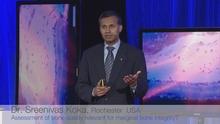-
0
Patient Assessment
- 0.1 Patient Demand
- 0.2 Anatomical location
-
0.3
Patient History
- 2.1 General patient history
- 2.2 Local history
-
0.4
Risk Assessment
- 3.1 Risk Assessment Overview
- 3.2 Age
- 3.3 Patient Compliance
- 3.4 Smoking
- 3.5 Drug Abuse
- 3.6 Recreational Drug and Alcohol Abuse
- 3.7 Condition of Natural Teeth
- 3.8 Parafunctions
- 3.9 Diabetes
- 3.10 Anticoagulants
- 3.11 Osteoporosis
- 3.12 Bisphosphonates
- 3.13 MRONJ
- 3.14 Steroids
- 3.15 Radiotherapy
- 3.16 Risk factors
-
1
Diagnostics
-
2
Treatment Options
-
2.1
Treatment planning
- 0.1 Non-implant based treatment options
- 0.2 Treatment planning conventional, model based, non-guided, semi-guided
- 0.3 Digital treatment planning
- 0.4 NobelClinician and digital workflow
- 0.5 Implant position considerations overview
- 0.6 Soft tissue condition and morphology
- 0.7 Site development, soft tissue management
- 0.8 Hard tissue and bone quality
- 0.9 Site development, hard tissue management
- 0.10 Time to function
- 0.11 Submerged vs non-submerged
- 0.12 Healed or fresh extraction socket
- 0.13 Screw-retained vs. cement-retained
- 0.14 Angulated Screw Channel system (ASC)
- 2.2 Treatment options esthetic zone
- 2.3 Treatment options posterior zone
- 2.4 Comprehensive treatment concepts
-
2.1
Treatment planning
-
3
Treatment Procedures
-
3.1
Treatment procedures general considerations
- 0.1 Anesthesia
- 0.2 peri-operative care
- 0.3 Flap- or flapless
- 0.4 Non-guided protocol
- 0.5 Semi-guided protocol
- 0.6 Guided protocol overview
- 0.7 Guided protocol NobelGuide
- 0.8 Parallel implant placement considerations
- 0.9 Tapered implant placement considerations
- 0.10 3D implant position
- 0.11 Implant insertion torque
- 0.12 Intra-operative complications
- 0.13 Impression procedures, digital impressions, intraoral scanning
- 3.2 Treatment procedures esthetic zone surgical
- 3.3 Treatment procedures esthetic zone prosthetic
- 3.4 Treatment procedures posterior zone surgical
- 3.5 Treatment procedures posterior zone prosthetic
-
3.1
Treatment procedures general considerations
-
4
Aftercare
Osteoporosis
Key points
- Osteoporosis is a systemic disease, affecting nearly 30 % of postmenopausal women, characterized by reduced bone density and impaired microarchitecture leading to bone fractures.
- Osteoporosis affects the jaw bone less than the extracranial skeleton.
- Reflecting current data the success of implant surgery in osteoporotic patients is not limited.
- Although antiresorptive medication is highly prescribed in osteoporosis a low risk of the antiresorptive medication related osteonecrosis of the jaw (ARONJ) exists, reflecting the low total dose over time application of antiresorptive medication in osteoporosis.
Osteoporosis
Osteoporosis is a frequent disease affecting predominantly postmenopausal women. The prevalence is 7% in women aged 55 and raises to 19% in women aged 80. Osteoporosis is diagnosed by a decreased radiologic bone density (DXA-score). Primary osteoporosis is more common and is due to age-related hormonal changes, whereas secondary osteoporosis results from the presence of underlying diseases such as diabetes, corticosteroid treatment. The clinical course of both forms is characterized by fractures and their consequences. The most common treatment is the administration of antiresorptive drugs (Bisphosphonates or Denosumab).
Specific aspects of osteoporosis in jaw bone and implant surgery
Osteoporosis is a significant risk factor when surgical procedures are performed in the extracranial skeleton. This fact resembles a challenge in implant surgery procedures. However, implant surgery in the jaw bone seems not to be affected by osteoporotic bone changes. The radiologic scores of osteoporosis (DXA-score) do not correlate between extracranial skeleton and jaw bone. The use of panoramic x-ray indices for the assessment of osteoporosis in the jaw bone is limited since the BMD significantly differs between different anatomic regions within the jaw bone. Recent data (meta-analysis of clinical data) did not find a significantly increased risk of oral implant failure in osteoporotic patients.
Treatment of osteoporosis and implant surgery
Medication related ostonecrosis of the jaw (MRONJ) can be triggered by oral surgical procedures carried out in patients with antiresorptive medication, as used in osteoporosis treatment. Other terms used are ARONJ (Antiresorptive drug Related OsteoNecrosis of the Jaw) and the former term BRONJ (Bisphosphonate Related OsteoNecrosis of the Jaw), which is presently replaced by the more current terms ARONJ and MRONJ.
In contrast to patients with malignant diseases, the risk of developing osteonecrosis as a result of antiresorptive therapy in osteoporotic patients is low, due to the lower total dose and the lower frequency of application. The success rates for implants placed in these patients appear to be not different from the success rates for implants placed in patients without a history of antiresorptive treatment. Discontinuing antiresorptive medication prior to implant surgery was not shown to lower the risk of osteonecrosis but increased the frequency of skeletal related events (SRE) (osteoporotic fractures).



